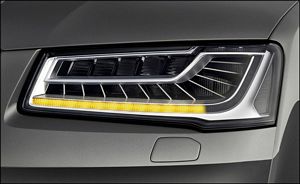|
By accessing or using The Crittenden Automotive Library™/CarsAndRacingStuff.com, you signify your agreement with the Terms of Use on our Legal Information page. Our Privacy Policy is also available there. |

And Audi Said - Let There Be Even More Light
|
|---|
|
|
And Audi Said - Let There Be Even More Light
Geoff Maxted
DriveWrite
December 8, 2013
The inexorable rise of technology continues. Prestige car makers, in an effort to keep one jump ahead of the competition, constantly evolve automotive science. This time it’s Audi’s turn. In its bid to overtake BMW as the world's best-selling luxury car manufacturer, Audi wants to dazzle, not blind, us with new lighting systems.
Next-generation headlamps provide a visible showcase of a brand's technology and are key to gaining an edge in the luxury-car market. Innovations such as bright, energy-efficient LED headlights, smart high beams, and infrared-assisted spotlights that shine on potential road-side threats like deer or drunks also help BMW, Audi and Mercedes-Benz justify higher prices than their mass-market competitors.
That’s the problem for the big brands. At a time when even the most inexpensive generic car on the road has improved in quality and accessories so the cost difference has to be justified with new innovations. Trick lights are something that potential buyers can actually see and be impressed by.
In a pitch-black museum hall near Dusseldorf, Germany, in October, Audi had a woman walk to and fro in front of a harsh white cone of light from a car's high beams. Instead of blinding the woman, who was carrying a flashlight to simulate a bike rider at night, the light automatically shied away from wherever she went while keeping the roadway lit. Audi's latest headlamp technology, which is more advanced than competing systems from BMW and Mercedes apparently, links computer-controlled LEDs with a camera to spare as many as eight vehicles from the glare of the high beams. The system, called Matrix LED, was introduced in Germany in mid-November as a €2,400 (£2011) option on the €74,500 (£62,500) A8 executive saloon.
The new Audi system combines 50 independently controlled LEDs to create almost one billion different light variations, adjusting for traffic situations such as city and highway driving and oncoming cars and bicycles, essentially redefining light.
Light-emitting diodes have replaced Xenon, which was first introduced by BMW in the 1990s, as the hot, new lighting technology for high-end carmakers. LEDs were used in headlights in 2007 by Lexus and closely followed by Audi, which had the first full-LED headlamps. LED technology uses less energy and lasts longer than traditional halogen bulbs, which have been the industry standard for decades. Crucially, the semiconductor-based lights can also be made smaller and offer more styling flexibility.
Yet it is not just a cosmetic exercise. Drivers with deep pockets are also willing to pay for advanced lights in that they are an aid to safety. Accidents at night tend to be more severe. In Germany twenty four percent of car crashes in the dark last year included deaths or severe injuries, compared with twenty percent in daylight, even though fewer cars are on the road. Sound justification then, especially when the new lights link to the navigation system and start illuminating corners even before the wheels are turned because the car knows where the road goes.
Although many drivers don’t want technology for technology’s sake, sometimes an idea is worth having. What we need now is for these lights to filter down the price bracket so that it’s not just wealthy drivers who benefit.

















 Topics: Audi
Topics: Audi

